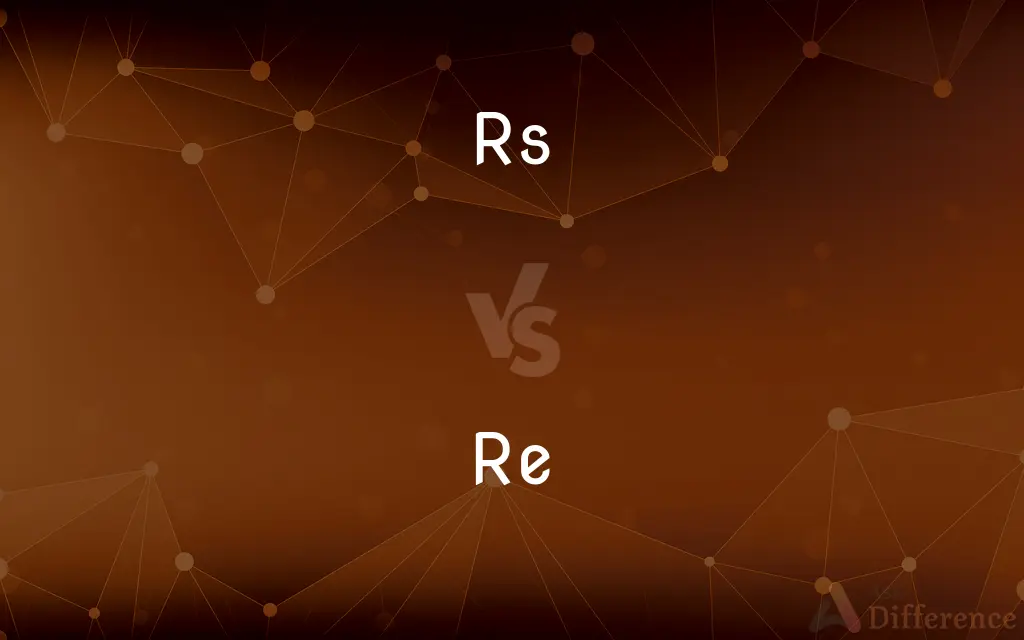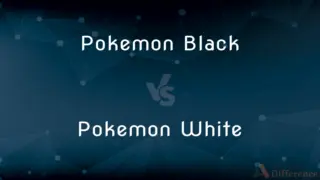Rs vs. Re — What's the Difference?
By Tayyaba Rehman — Published on November 25, 2023
"Rs" refers to Indian Rupees in plural while "Re" refers to a singular Indian Rupee. Both are symbols for currency denominations in India, with "Re" being rarely used in everyday language due to the low value of a single rupee.

Difference Between Rs and Re
Table of Contents
ADVERTISEMENT
Key Differences
In discussing "Rs" and "Re," one recognizes "Rs" as a term employed to represent the Indian currency in its plural form. The term "Rs" implies more than one rupee, essentially symbolizing a common unit of currency in India. On the other hand, "Re" is utilized when referring to exactly one Indian rupee. Despite its official status, "Re" is scarcely used in common parlance, given the relative purchasing power of one rupee in the current economic context.
"Rs" commonly finds its application in various financial contexts, including pricing, budgeting, and accounting, where values exceed one rupee. "Re," however, is mostly observed in historical contexts or legal documents where precision in the currency amount is paramount. When observing market prices or in conversation, the term "Re" is rarely encountered due to the minimal value one rupee currently holds.
While "Rs" is widely recognized and used both in spoken and written English in India, it's pertinent to note that "Re" has somewhat faded from general usage, particularly in casual conversation and pricing in shops. In formal writing, legal documentation, or instances requiring strict financial accuracy, "Re" is employed to signify a singular rupee, maintaining its importance and relevance in specific contexts.
In digital contexts like online transactions and digital pricing, "Rs" is predominantly employed to convey prices, owing to the commonality of dealing with amounts larger than one rupee. Contrarily, "Re" would predominantly be utilized in digital platforms if a transaction or product pricing is precisely one rupee, which is a rare scenario due to the currency's depreciation and inflation.
It is noteworthy that while "Rs" and "Re" pertain to the same currency, their application in language and writing is distinguished by the quantity they signify. "Rs" will continue to be widely used due to the practicality of its application in various contexts. Meanwhile, "Re" sustains its utility in specific, formal, or legal circumstances where accuracy is obligatory, thereby preserving its presence in the lexicon.
ADVERTISEMENT
Comparison Chart
Meaning
Indian rupees
One Indian rupee
Usage
Common
Rare
Application
Plural amounts
Singular amount
Contextual Relevance
High
Low
Formal Usage
General
Specific
Compare with Definitions
Rs
"Rs" is utilized to convey amounts in Indian currency in written form.
I paid Rs 200 for the book.
Re
"Re" might be employed in nostalgic or historical contexts reflecting past prices.
Back in the day, a loaf of bread cost Re 1.
Rs
"Rs" symbolizes monetary values exceeding one rupee in India.
The shirt is priced at Rs 1500.
Re
"Re" is applied in formal contexts where precise financial notation is required.
The document stated a fee of Re 1.
Rs
"Rs" is employed in financial documentation to represent rupee values.
The fee of Rs 300 must be paid by Friday.
Re
"Re" appears in legal and official documents to represent a single rupee.
A nominal Re 1 was charged for the registration.
Rs
"Rs" denotes the plural form of the Indian Rupee.
The total cost is Rs 500.
Re
"Re" is used to symbolize a singular unit of the Indian Rupee.
A candy used to cost Re 1 in the past.
Rs
"Rs" is the standard notation in digital platforms for Indian currency.
The online course costs Rs 2500.
Re
The second tone of the diatonic scale in solfeggio.
Rs
Plural of r
Re
Variant of Ra1.
Re
In reference to; in the case of; concerning.
Re
About, regarding, with reference to; especially in letters, documents and emails.
Re
(music) a syllable used in solfège to represent the second note of a major scale.
Re
A syllable applied in solmization to the second tone of the diatonic scale of C; in the American system, to the second tone of any diatonic scale.
Re
A rare heavy polyvalent metallic element that resembles manganese chemically and is used in some alloys; is obtained as a by-product in refining molybdenum
Re
Ancient hawk-headed Egyptian sun god; a universal creator
Re
The syllable naming the second (supertonic) note of any major scale in solmization
Re
"Re" designates the Indian currency when referring to exactly one rupee.
He gave me Re 1 as a token of luck.
Common Curiosities
What does "Rs" stand for in financial terms?
"Rs" stands for Indian Rupees, representing the currency in plural.
Is "Re" used in legal documents?
Yes, "Re" can be used in legal documents when referring to exactly one rupee.
Why is "Rs" more commonly used than "Re" in the current context?
"Rs" is more common due to its applicability to most practical financial values above one rupee.
Can "Re" be used to denote decimal values like Re 1.50?
No, "Re" denotes exactly one rupee; for values above that, "Rs" is used.
Is "Re" commonly used in daily conversation in India?
No, "Re" is rarely used in everyday conversation due to the low value of a single rupee.
How prevalent is the use of "Rs" in digital transactions in India?
"Rs" is widely used in digital transactions to denote amounts in Indian currency.
Is it grammatically correct to use "Rs" before every amount?
Yes, it's common to use "Rs" before amounts to denote they are in Indian Rupees, like Rs 500.
Can "Rs" and "Re" be used interchangeably?
No, "Rs" is used for more than one rupee, while "Re" is used for exactly one rupee.
In which contexts is "Re" still relevant to use?
"Re" is relevant in specific, formal, or legal contexts requiring precise notation of one rupee.
Do any other countries use "Rs" to represent their currency?
Yes, "Rs" is used by several countries in South Asia, including Pakistan and Sri Lanka, to denote their respective currencies.
How is "Re" used in the context of Indian currency?
"Re" is used to denote a singular unit of the Indian Rupee.
How does the use of "Rs" and "Re" change in spoken versus written English?
"Rs" is common in both, while "Re" is rarely spoken and mostly used in precise written contexts.
Are "Rs" and "Re" the official symbols for the Indian currency?
No, the official symbol is "₹", but "Rs" and "Re" are widely accepted and understood notations.
How can one differentiate between the rupee denominations of different countries using "Rs"?
The context, such as the country of discussion or transaction, typically clarifies which country's rupees are being referenced.
Is it mandatory to use "Re" when referring to a single rupee in legal texts?
While it's not mandatory, using "Re" in legal texts can provide clarity when specifying one rupee.
Share Your Discovery

Previous Comparison
Pokemon Black vs. Pokemon White
Next Comparison
Meristematic Tissue vs. Ground TissueAuthor Spotlight
Written by
Tayyaba RehmanTayyaba Rehman is a distinguished writer, currently serving as a primary contributor to askdifference.com. As a researcher in semantics and etymology, Tayyaba's passion for the complexity of languages and their distinctions has found a perfect home on the platform. Tayyaba delves into the intricacies of language, distinguishing between commonly confused words and phrases, thereby providing clarity for readers worldwide.













































